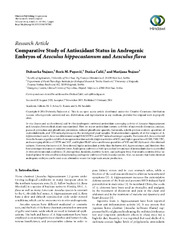Приказ основних података о документу
Comparative Study of Antioxidant Status in Androgenic Embryos of Aesculus hippocastanum and Aesculus flava
| dc.creator | Štajner, Dubravka | |
| dc.creator | Popović, Boris M. | |
| dc.creator | Ćalić, Dušica | |
| dc.creator | Štajner, Marijana | |
| dc.date.accessioned | 2016-05-23T11:00:48Z | |
| dc.date.available | 2016-05-23T11:00:48Z | |
| dc.date.issued | 2014 | |
| dc.identifier.issn | 1537-744X | |
| dc.identifier.uri | https://radar.ibiss.bg.ac.rs/handle/123456789/2301 | |
| dc.description.abstract | In vivo (leaves and seed embryos) and in vitro (androgenic embryos) antioxidant scavenging activity of Aesculus hippocastanum and Aesculus flava medical plants was examined. Here we report antioxidant enzyme activities of superoxide dismutase, catalase, guaiacol peroxidase and glutathione peroxidase, reduced glutathione quantity, flavonoids, soluble protein contents, quantities of malondialdehyde, and (OH)-O-center dot radical presence in the investigated plant samples. Total antioxidant capacity of all the samples of A. hippocastanum and A. flava was determined using FRAP, DPPH, and NO center dot radical scavenger capacity. The leaves of A. flava collected from the botanical garden exhibited stronger antioxidant activity (higher activities of SOD, and higher quantities of GSH, TSH, TPC, and scavenging abilities of DPPH and NO center dot, and higher FRAP values and lowest quantities of (OH)-O-center dot and MDA) than in vitro obtained cultures. However, the leaves of A. flava showed higher antioxidant activity than the leaves of A. hippocastanum, and therefore they have a stronger tolerance of oxidative stress. Androgenic embryos of both species had low amount of antioxidants due to controlled in vitro environmental conditions (T, photoperiod, humidity, nutritive factors, and pathogen-free). Our results confirmed that we found optimal in vitro conditions for producing androgenic embryos of both Aesculus species. Also, we assume that horse chestnut androgenic embryos can be used as an alternative source for large-scale aescin production. | en |
| dc.description.sponsorship | Ministry of Education, Science, and Technology Development of Serbia {[}III43002, 173015] | |
| dc.language | English | |
| dc.relation | info:eu-repo/grantAgreement/MESTD/Integrated and Interdisciplinary Research (IIR or III)/43002/RS// | |
| dc.relation | info:eu-repo/grantAgreement/MESTD/Basic Research (BR or ON)/173015/RS// | |
| dc.rights | openAccess | |
| dc.rights.uri | https://creativecommons.org/licenses/by/4.0/ | |
| dc.source | Scientific World Journal | |
| dc.title | Comparative Study of Antioxidant Status in Androgenic Embryos of Aesculus hippocastanum and Aesculus flava | en |
| dc.type | article | |
| dc.rights.license | BY | |
| dcterms.abstract | Стајнер, Маријана; Поповиц, Борис М.; Стајнер, Дубравка; Ћалић, Душица Д.; | |
| dc.rights.holder | © 2014 Dubravka Štajner et al. | |
| dc.citation.issue | 767392 | |
| dc.identifier.doi | 10.1155/2014/767392 | |
| dc.identifier.pmid | 24672369 | |
| dc.identifier.scopus | 2-s2.0-84898820557 | |
| dc.identifier.wos | 000331826400001 | |
| dc.type.version | publishedVersion | en |
| dc.identifier.fulltext | https://radar.ibiss.bg.ac.rs/bitstream/id/6008/767392.pdf | |
| dc.citation.rank | M21 | |
| dc.citation.rank | M21 |

